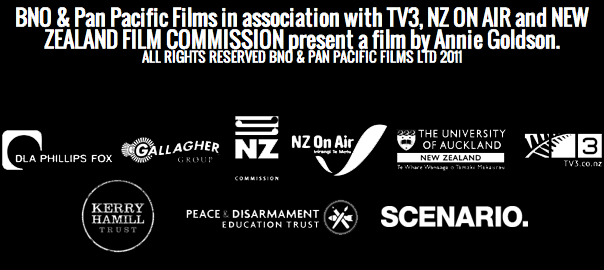-
Lead up to 'The Broadcast'
BNO's broadcast is coming up this Thursday on TV3, which is exciting. Once again, we've had some great reviews so thanks to the Herald, the Listener and of course to TV3. The film has done well in festivals and in its theatrical release, but it is great to reach bigger, and sometimes random, audiences through the "box" (free to air at least).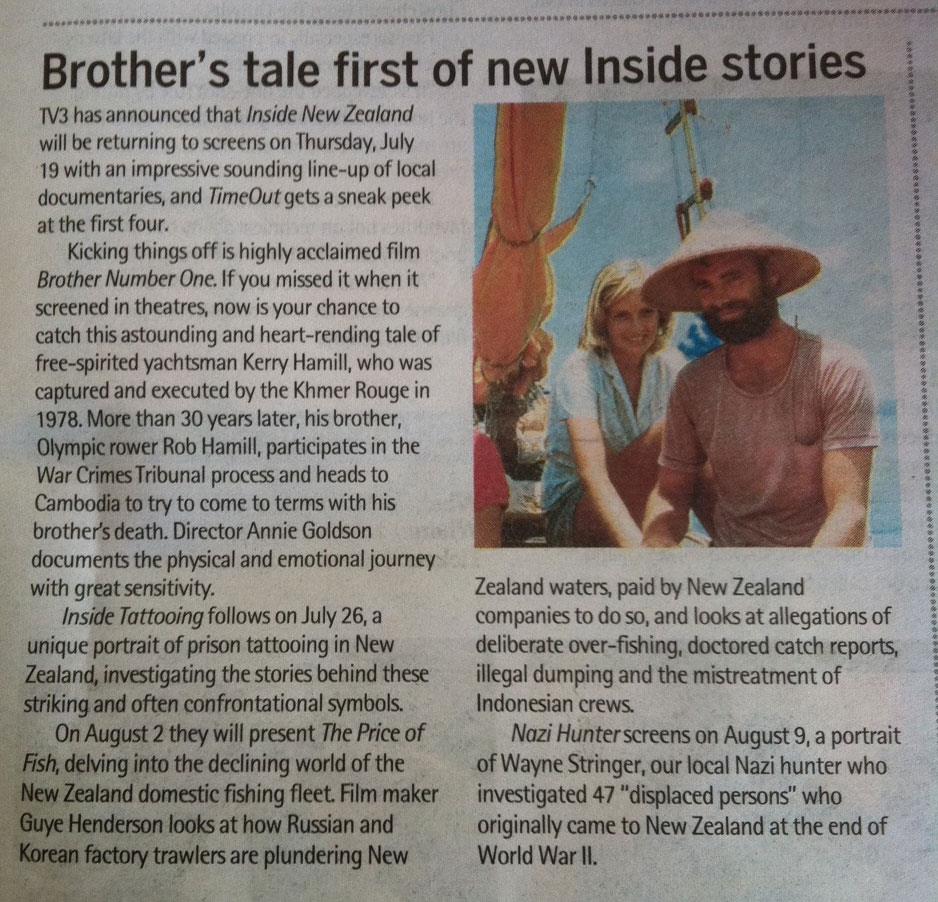 And cheers, too, to TV3 for having BNO kick off Inside New Zealand, and for retaining a primetime documentary strand for Kiwi filmmakers.
And cheers, too, to TV3 for having BNO kick off Inside New Zealand, and for retaining a primetime documentary strand for Kiwi filmmakers.Apart from these occasional brightspots, the broadcasting outlook is bleak for local makers. I for one, miss TVNZ7 as do my friends and family. The Government’s logic that we have more “choice” and “digitalization” so we don’t need TVNZ7 is pretty flawed. Media Studies 101 classes point out the more “choice” some of us have (the half of us that can afford Sky), the more New Zealand content, particularly public broadcasting, is drowned out by international imports. TVNZ7 had a tiny budget compared to some of the consultancy fees currently being doled out and the producers and creatives did a fine job.
The broadcast version of Brother Number One airing Thursday is half the length of the original film given it needed to conform to a television hour. Content is always hard to lose, as filmmakers will testify, but we see it as a different film and think/hope it works. Much pacier and more focused around Rob's story.
Once the broadcast is over, we are releasing a DVD of the feature version which will be available on our website, brothernumberone.co.nz (an English version AND a Khmer version). And for those involved in education or who are just interested (in the history of war crimes tribunals since Nuremberg, the Cold War, Vietnam and Cambodia, textual analyses of documentary, exploring differing viewing contexts (cinema vs TV) etc.), there are a lot more clips and information in our two study guides online (with an answer booklet forthcoming). They conform to NCEA specs but are also suitable for university students and adults and have lots of additional clips and outtakes.
As someone who straddles the worlds of film and television (and university for that matter), I’m sad to see the demise of the film awards and congrats to the Director’s Guild who helped managed them so adeptly for many years. They were expensive and demanding to run (and all the Guilds have faced cutbacks), and yes, there was a tension between the high profile commercial and competitive prerogatives of broadcasters and the more varied palate that film culture engages with. In the “old days” in fact, there had been separate film and television awards . . so maybe, again, we will be reinventing the wheel.
Anyway, I hope you all tune in on Thursday night, TV3 – and be great to get your feedback on Facebook. All good on the international front with our fabulous sales agent Cargo Film and Releasing getting great distributors on board.- Annie Goldson
Continue reading -
BNO graces the pages of The Listener
Continue reading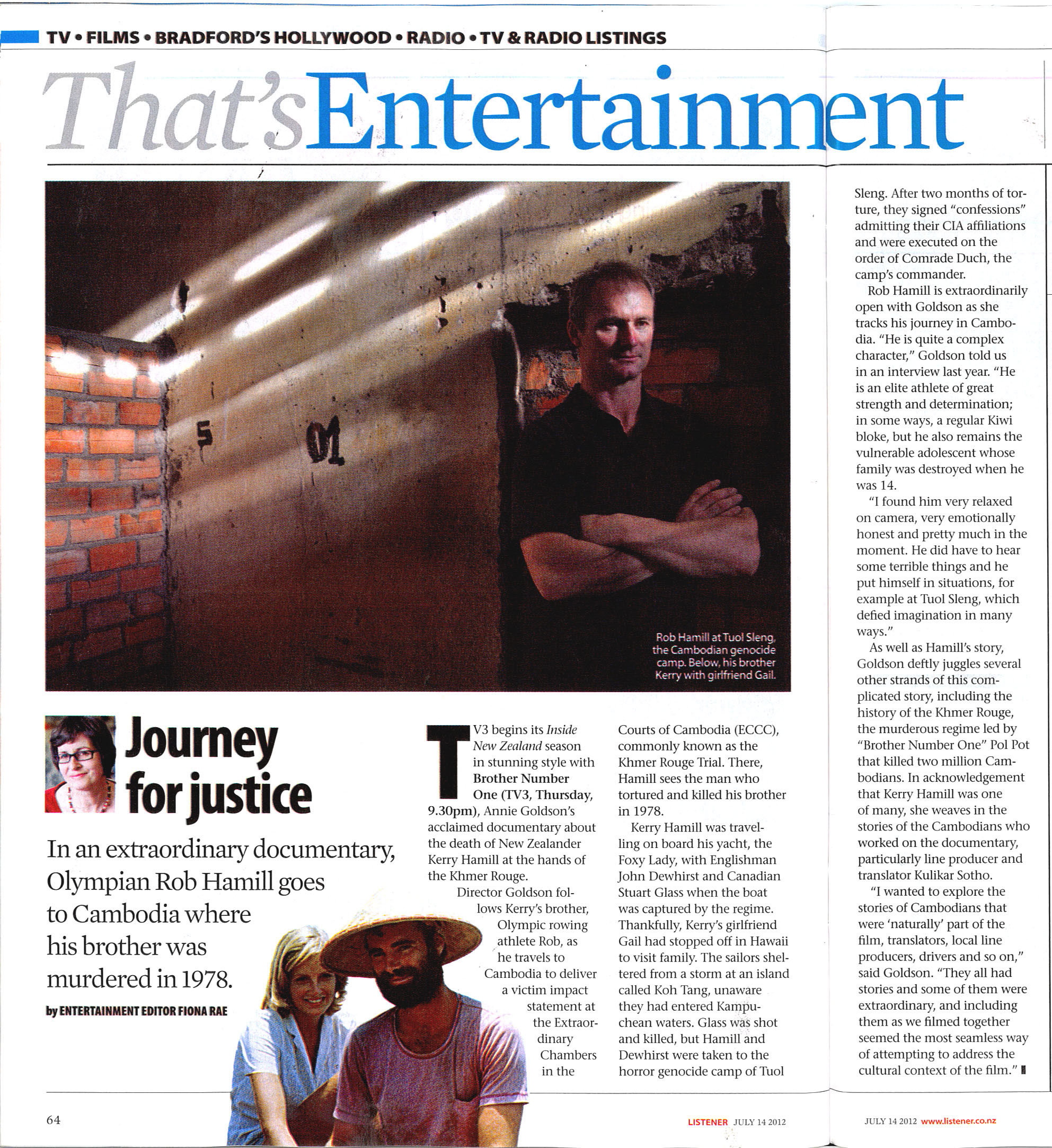
-
Almost One Year On
It’s nearly a year now since Brother Number One was finished, and it has been quite a journey since then, a fulfilling and busy one. We’ve had some great audiences here in Aotearoa and around the world – Rob and I have traveled to various festivals in Amsterdam, Melbourne, Biarritz, Adelaide, London, and on our way to New York too. What has been moving is meeting Cambodians in most of the places we visit, many of them still having to deal with the memories of the past and the challenges of living in diaspora.
Speaking of that, I had a rewarding evening last week speaking at an exhibition In Spite of Ourselves: Approaching Documentary at the St Paul Gallery in Auckland which included Vandy Rattana and his series Bomb Ponds, images of the Cambodian landscape marred by American bombs during the Vietnam War. To me, their tranquility today still evokes the violence of the past.
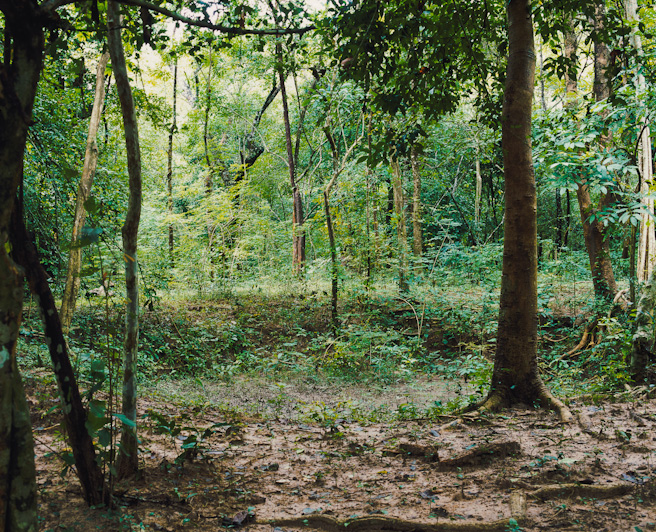 Image / Vandy Rattana
Image / Vandy RattanaThe theatrical release of Brother Number One went well in Aotearoa. We launched the film in early March and only winding up over the last fortnight. A two-month run is not bad given the very commercial environment that rules cinema distribution. Many cinemas, including the Rialto and the Bridgeway were generous and very helpful. Our trick was to keep the P and A distribution costs really low. Some generous sponsors helped us with the essential costs, the reviewers were generous and we worked hard creating two study guides, one for English and Media Studies and the other for History and Social Studies, which extended our audience to secondary schools.
Our next international screening is coming up New York, where we will be screening the film as part of the Human Rights Watch film festival at the Lincoln Centre no less. New York is one of my old hometowns – I lived there from 1981 to 1993 although the city has changed, although probably not as much as I have from my days as a young punkish rocker.
The Human Rights Watch Fest have been really supportive, always have great venues and they’re including BNO in their travelling festival visiting something like 25 cities in Canada and the US,showing in cinemas and universities.
The broadcast of Brother Number One is most likely to happen early July, soon after we return from NYC – it is shorter than the feature version, but has its charms and the beauty of TV of course is reaching such a big audience. And following the TV3 screening, we’ll release the DVD, planning both a premium education pack (with an answer booklet to the guides), and a Khmer version that our colleague Chakara Lim translated and subtitled.
David Piperni from Cargo Film and Releasing, our distributor, took Brother Number One to MIPDOC, which I think is the biggest documentary market in the world. It was one of about 20 or so “must see” titles recommended by Realscreen, which is pretty good, given I think there are about 6000 all up. Hopefully, this will all translate to distribution and help Brother Number One continue to reach audiences everywhere.
- Annie Goldson
Continue reading -
Nominated for the Human Rights Defender Award
Annie and Rob were nominated for the Human Rights Defender Award which was presented in May 2012 in Auckland. Congratulations to the very deserving award winner Keith Locke. It was an honour to be in the company of such inspiring nominees.
Continue reading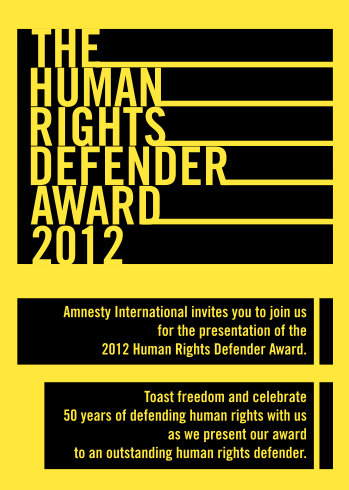
-
Thanks for having us London
Thanks to John Biaggi and Andrea Holley and all the HRW team - great festival!
We had a fantastic premiere screening at the Curzon in Soho with a big audience of 150+. Quite a lot of ex-pats by the sound of the Q and A. They've also made some lovely posters for each of the films that form a little exhibition at the Curzon.
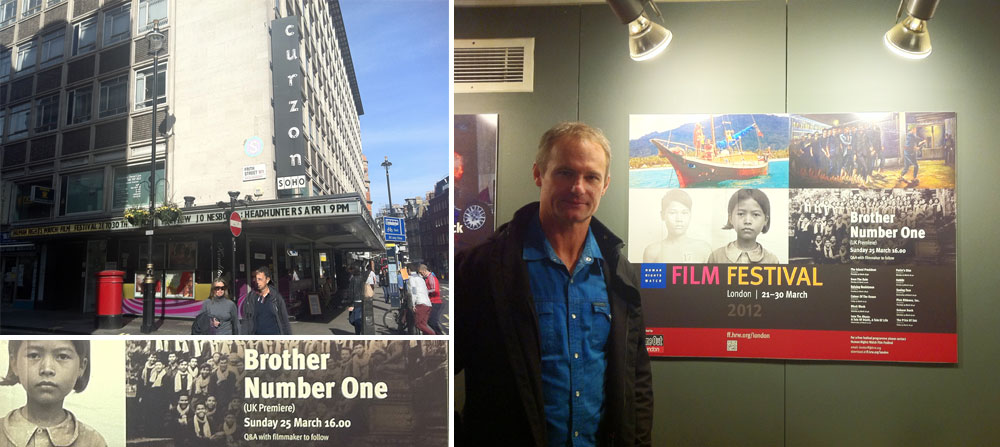
We sold out at The Ritzy for the last screening. It was great to have Alain Werner, one of the lawyers in the film, able to attend this screening and update us all on the case. Here's the before, during and after:
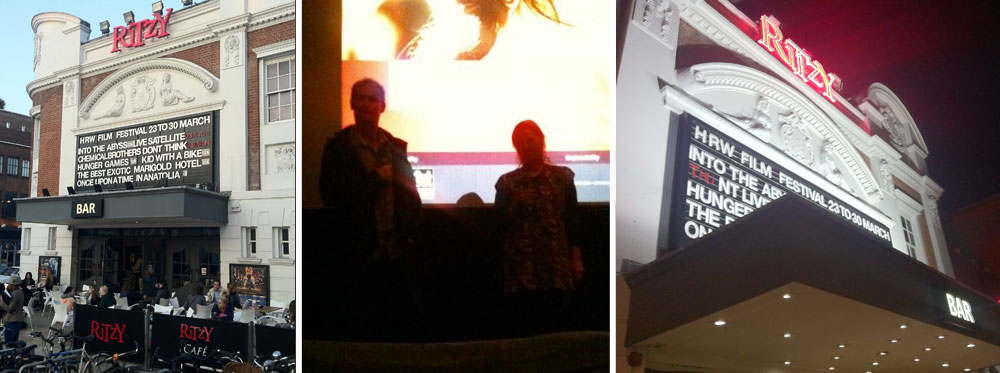
Lovely for me to meet other filmmakers and I'm staying in a lovely hotel right in historic Kensington, on a 4th floor which once must have been a maid's room.
Continue reading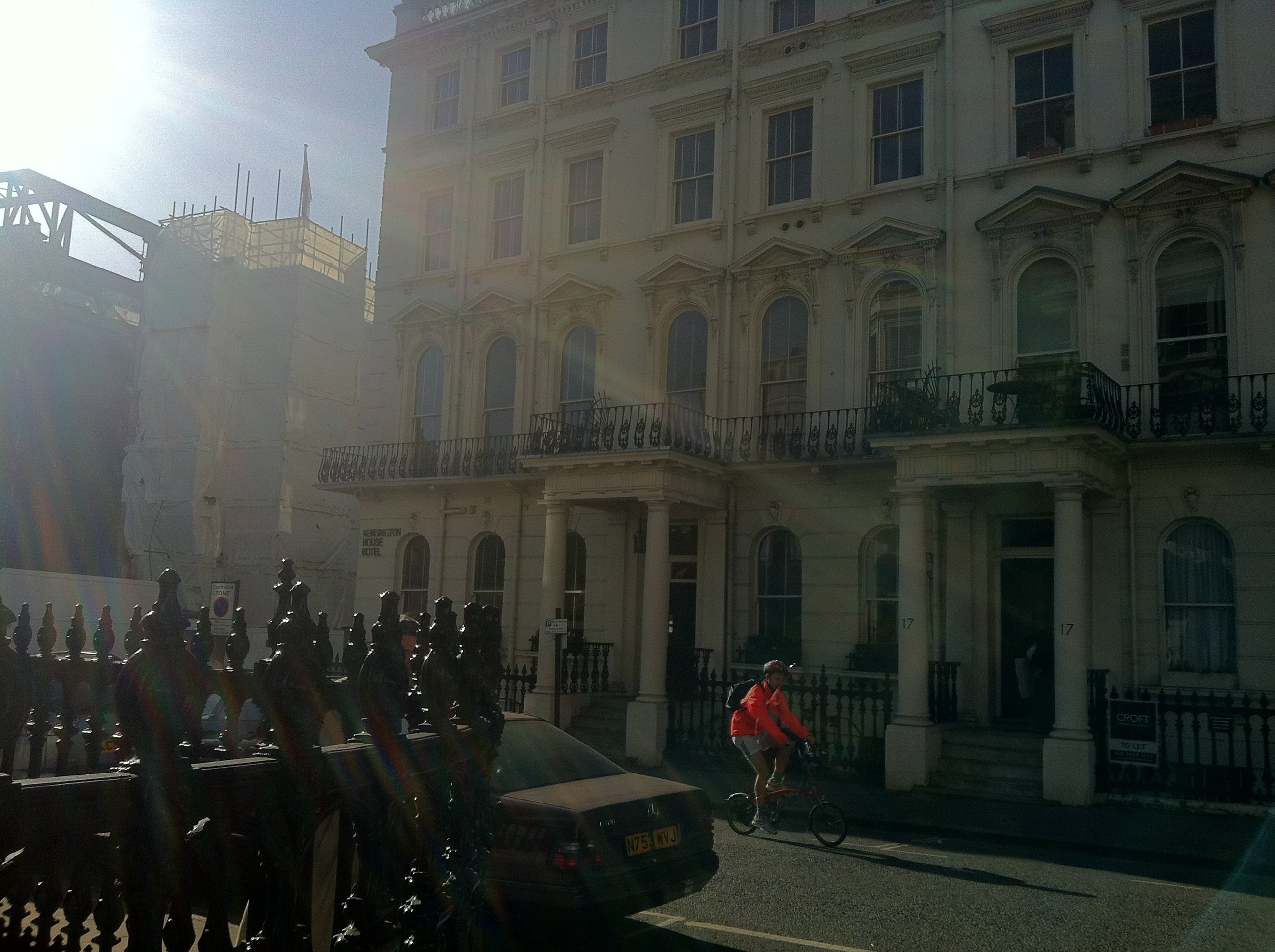
-
Exhibition: A reporter’s dangerous guided tour through Democratic Kampuchea
Elizabeth Becker was one of only two Western journalists allowed to visit Cambodia under the Khmer Rouge. In 2011 she donated digital copies of the color photographs and recorded interviews she made on the rare 1978 reporting trip to Cambodia under the Khmer Rouge to the Bophana Center in Phnom Penh.
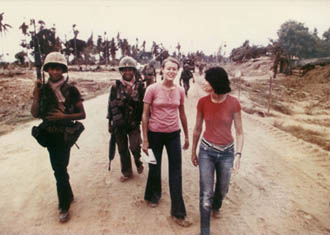
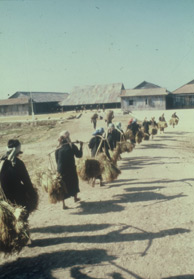
Last month the Bophana Centre held an Exhibition of her work which she attended:
The open-air gallery was packed. Cambodians lingered over the photographs of the empty city of Phnom Penh under the Khmer Rouge, of Pol Pot and other leaders, of rural scenes, of an empty Angkor Wat and of soldiers preparing for battle on the eastern front. They pulled on headphones to hear the voices of Pol Pot, Ieng Sary and Ieng Thirith on my recorded interviews.
Surprisingly, I saw Cambodians taking each other’s photographs in front of my large portrait of Pol Pot. When I asked one young woman why, she answered that she had never seen a photograph of Pol Pot before and that some of the young people questioned whether he existed. I couldn’t have been happier to see my thirty year old photographs and recordings boost interest in discovering the history of that unspeakable time.
- Excerpt from Elizabeth's guest blog on New Mandala
Continue reading -
2012: Director's Update
Brother Number One is now fully entrenched in the festival circuit – Rob and I made it to Melbourne, and the to IDFA in Amsterdam of course, and then before the jetlag was even over, off he went to Biarritz to FIPA, which required us (at pretty short notice) to produce a French subtitled version as it was in competition. I wrestled with Google Translate and my schoolgirl French until the wonderful Deborah Walker, translator extraordinaire, rescued me. In the meantime, Chakara is doing a Khmer version, which looks beautiful with such graphic text.
I’m off to Adelaide (not Biarritz I know) to AIDC where I’m going to be something called an F4 master, and then Rob and will be off the London for the Human Rights Watch Film Festival (for those in the UK, log onto http://ff.hrw.org/london, showing at the Curzon Soho and the Ritzy Cinema, both of which sound very London-esque and non-multiplex. Has a great lineup of films and I know they work hard to bring filmmakers together so that will be a blast – and it will be great to catch up with John Dewhirst’s family too who will come down from the Lake Districts to the screening.
We have now signed with a distributor too, Cargo Releasing who are supportive and organized . . so many of my summer days have been spent in editing rooms, subtitling and editing down broadcast versions. Just as well we had a lousy summer.
More news too, we have written two study guides, with most of the writing by Amy West, a PhD graduate from the University of Auckland. One is for English and Media Studies, and the other History and Social Studies. Brother Number One does seem to address such a range of issues and we had such a rich bank of archives, it seemed a no-brainer really to try to reach out to schools and universities. Kate Stevenson has been wonderful as always, managing her partners highly successful gaming site and working hard to organize the guides online, contact the teachers and all. Lots of clips online if you click on the website.
Continue reading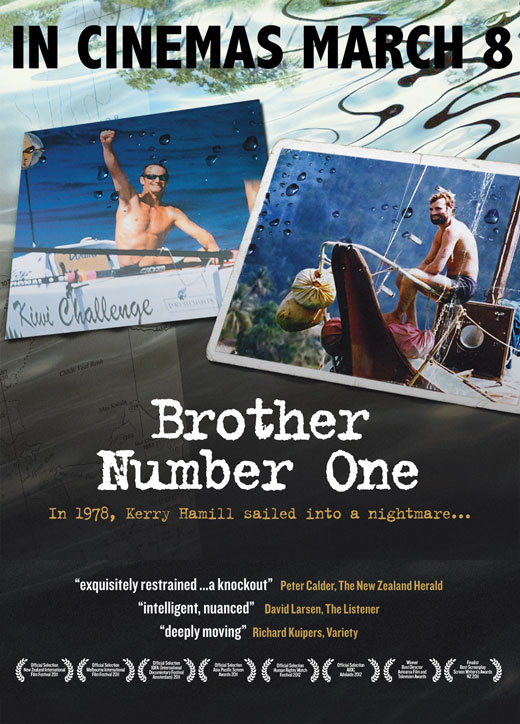
And the other big thing is we are going into a theatrical run here in New Zealand, pretty much nationwide we think. Whereas this is no blockbuster perhaps, we think it has widespread appeal and the critics have been uniformly very positive. Our P and A (publicity and advertising) budget is pretty modest, so word of mouth will be important, so any help from you all would be fantastic. -
Report from IDFA
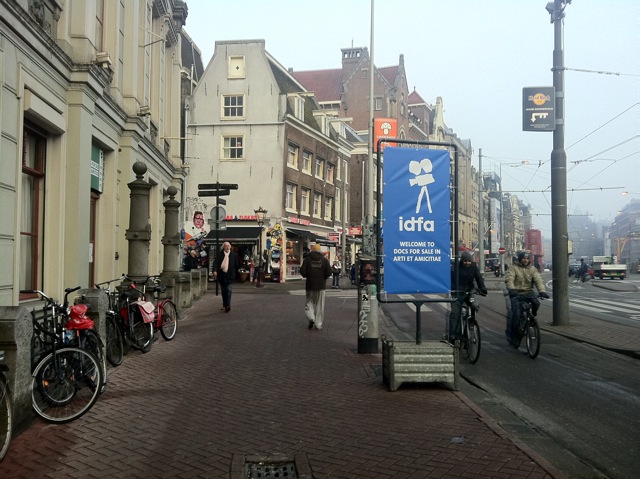 Lovely Amsterdam, so different as a city to Auckland. Canals and trams and bicycles and historic buildings, cheese and chocolate. A different sense of history for sure. IDFA’s signs are everywhere, from its tent, to Docs for Sale and the Forum through to the various cinemas. Rob arrived and the man that ate fried tarantulas in Cambodia headed for the handmade chocolate shop in Amsterdam. Always prepared to sample local delicacies.
Lovely Amsterdam, so different as a city to Auckland. Canals and trams and bicycles and historic buildings, cheese and chocolate. A different sense of history for sure. IDFA’s signs are everywhere, from its tent, to Docs for Sale and the Forum through to the various cinemas. Rob arrived and the man that ate fried tarantulas in Cambodia headed for the handmade chocolate shop in Amsterdam. Always prepared to sample local delicacies.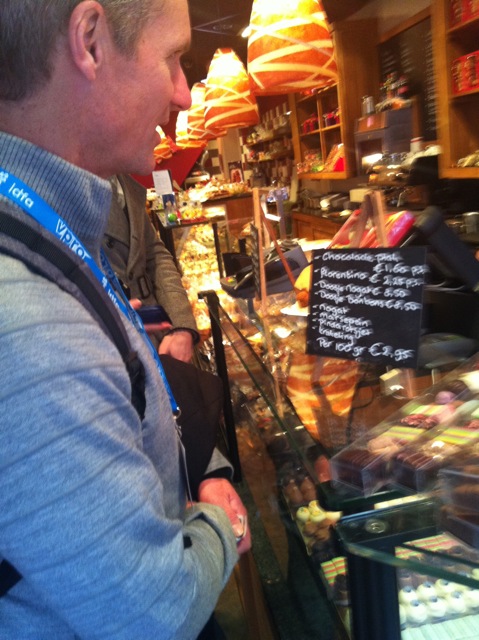
I have been incredibly busy with meetings. My strategy right or wrong was to pre-arrange meetings with distributors and sales agents, meet with them, then follow up to see who is interested and what the best “fit” would be. So I plunged jet lag and all, mostly meeting at Docs for Sale, a digitized bank of docs, including BNO – most buyers if they are not attending the pitch forum listening to, and hopefully investing in, new projects are skimming their way through the documentary bank.
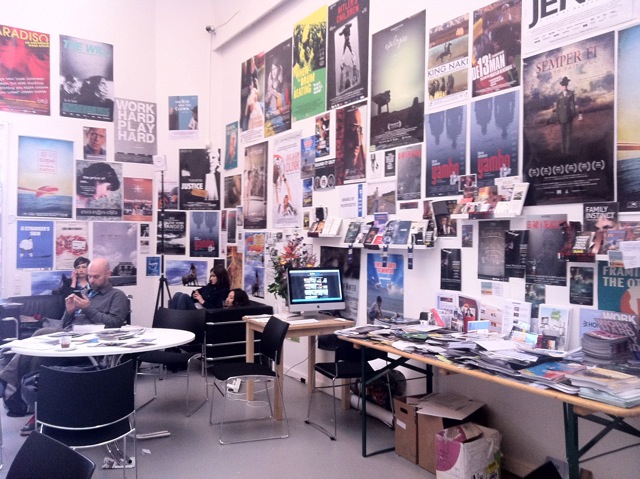
Our screenings have gone well: one daytime one, and one tonight at 10.15 pm and then another Saturday at 4.15 which is a good time given the chill in the air. People here are hugely multi-lingual and the lingua franca is English rather than Dutch, which is convenient and they all pick up on the nuances within the film. The audiences here are moved as elsewhere and the questions pretty much follow similar lines as they have in New Zealand and in Australia.
There are strong Kiwi connections here – the volunteer who picked us up has a mother from Palmerston North and Rob and I will be talking on a radio show called English Breakfast, subscribed to by the large Kea community here. The journalist was born in New Zealand to Dutch parents.
With the film screenings having gone well so far I am now, finally, getting a chance to look at some of the films myself. Making “engaged” creative documentaries may be harder these days as broadcasters head towards popular factual but clearly look at the range and depth of works here, there are still many filmmakers sufficiently passionate and/or crazy to keep it up.
Here is a video of one of the Q&As:
Continue reading
-
Best Director for Brother Number One’s Annie Goldson
University of Auckland Media Release | 17 November 2011
Professor Annie Goldson from the Department of Film Television and Media Studies has been named Best Director Documentary at the AFTAs, the Aotearoa Film & Television Awards (formerly Qantas).
The award was for her film Brother Number One, a powerful documentary on the torture and murder of New Zealand yachtie Kerry Hamill by the Khmer Rouge in 1978. The film follows the journey of Kerry’s younger brother, Rob Hamill, who travels to Cambodia to retrace those fateful steps taken by his brother.
“We worked extremely hard to bring this film to the screen and it is an honour to receive recognition. Rob was a great character to work with and it was such an important story to tell,” Annie says.
The AFTAs recognise excellence in the New Zealand Film and Television industries and were presented at the Viaduct Events Centre on Saturday 12 November.
Brother Number One was launched at the New Zealand International Film Festival earlier this year. It was also selected for the Melbourne International Film Festival and will screen at the 24th International Documentary Film Festival in Amsterdam later this month. It is due for a general theatrical release at selected cinemas in March 2012.
The film involved Masters students from the University’s FTVMS department - graduates Melissa Kent (archivist), Creda Wilson (assistant editor), Kate Stevenson (publicity and outreach), as well as current Masters student and recent Fulbright scholar Ghazaleh Golbakhsh (director’s assistant).
Annie Goldson is well-known for her powerful films and has been producing and directing award-winning documentaries, docudramas and experimental film and video for 20 years. Her next projects include a documentary for Maori Television titled He Toki Huna; and a docudrama William Mariner and the Port au Prince, an early Pacific contact story based in Tonga. Annie is co-producing and co-directing the film with Rebecca Kelly. William Mariner received funding from the FRDF fund and also from the Screen Producer’s Association after it won Best Pitch for a new film.
Brother Number One was funded by TV3, NZ on Air, the New Zealand Film Commission with generous support from The University of Auckland Faculty of Arts research fund.
Continue reading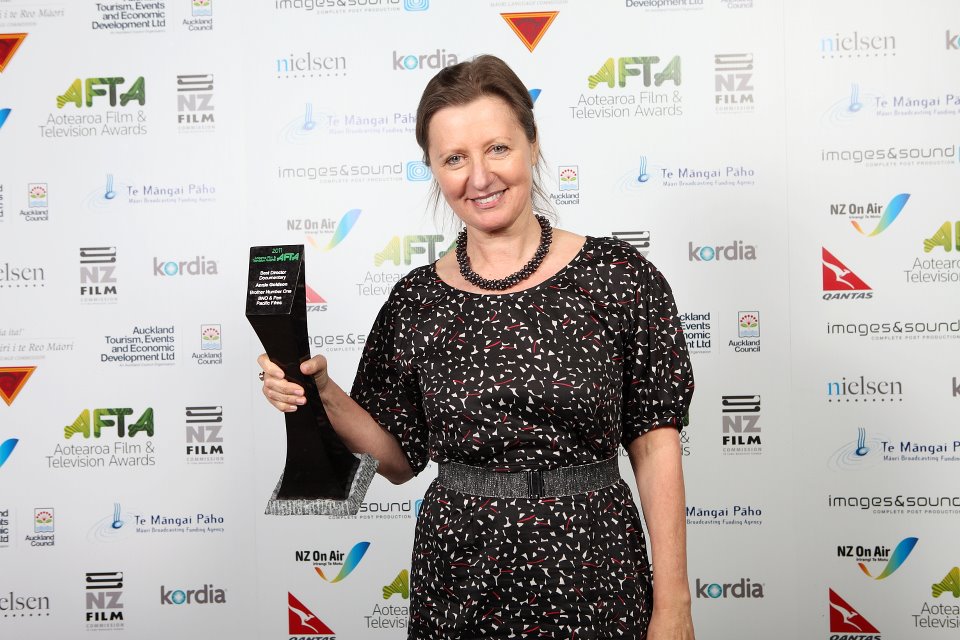
-
NZIFF has been a blast!
The New Zealand Film Festival has been a blast, and now is slowly drawing to a close (with Hamilton, Nelson & New Plymouth still to go). It has been fun traveling with the film, and it strikes me how different our cities are in New Zealand, quite different in feel, geography, character and architecture.
We managed to get marooned in Dunedin in the snow for an extra couple of days: magical, except we never left the Octagon and in Christchurch I managed to get in some disaster tourism (ferried around by the generous Nick Drake), and experienced my own vigorous aftershock. I also had quite a Wellington experience staying at the fabulous Museum Hotel. I walk in and there is Stephen Fry being interviewed (in town for The Hobbit) in front of the classic wearable arts ensemble – a suit of armour made of used teabags.

Audiences have been really appreciative of the film, and we have some received some heartfelt comments on Facebook. Our joke is that we should have gotten Kleenex as a sponsor. In Auckland, Wellington and Christchurch we opened the film with Cambodian dancers – dressed in their gold and silk, elegant and gracious. Not only did this add greatly to the feel of the film, but meant we also liaised closely with the local community in those cities. Chakara Lim, our associate producer, has been able to draw dancers together seemingly effortlessly up and down New Zealand although I know how hard he works behind the scenes. I think that the dancers really helped to get the word out and draw the Cambodian community to the film.
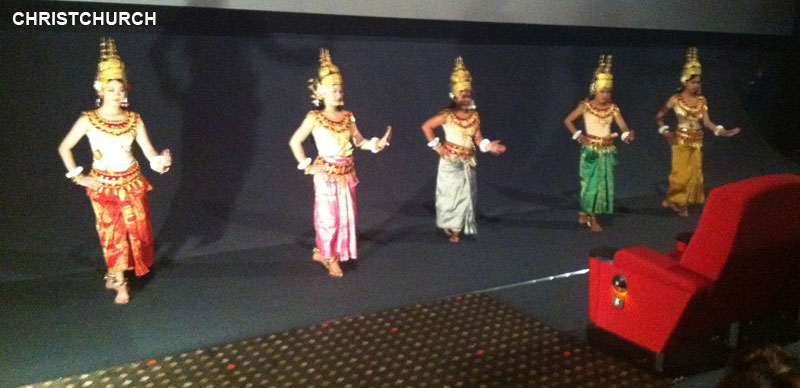
It is interesting to hear what people say in the Q and A, too. “Did you ever ask the Karma question of Duch?” is asked frequently, and many have asked Rob if he feels his journey, and the film, has helped him. Many thank him for his courage and emotional honesty.
Next is a short sweet theatrical so let’s hope we are coming to a theatre near you . . . more on that very soon!
- Annie
Continue reading -
Brother Number One launch in Auckland and Melbourne
So Brother Number One is finally completed and launched which has involved moments of apprehension, relief and excitement.
I often think of documentary filmmaking as sculpture. After months of chipping away at hard rock (230 +hours of footage) an amorphous lumpy shape emerges. This is then honed and polished and honed again and begins to look like a film. The process, though it has its pleasures, is simultaneously nerve-wracking and tedious; you don’t know if you even have a film until the shape emerges and it just takes such a long time, endless hours, to discover it. Then everything accelerates all of a sudden, small changes make heaps of difference, and you, or you and your editor, having worked in relatively solitary fashion, are now joined, budget permitting, by a wave of fresh creativity - musicians, composers, graphic designers, colour graders, sound designers and mixers, online editors and so on.
Towards the end of the film, the relationship of filmmaker to subject also shifts and becomes central to the process again, as it had been in production. I usually keep subjects away from the editing room until the assemble edit is semi-coherent, as it takes considerable experience and effort to sit through 4+ hours of rough sequences. But once it is at about say two and a half, I bring the subject in and discussions begin. I am always clear that editorial responsibility has to lie with the director as there needs to be a single shaping vision. But then I welcome comment and critique and am always prepared to discuss any issues and problems. Rob has been fantastic, making thoughtful and useful suggestions that we incorporate while at the same time, after some fairly vigorous debates, accepting scenes that James Brown, the editor and I, were reluctant to change.
Premiere Screening -- Auckland from BNO Team on Vimeo.
For once, I finished the film well in time, two weeks before its premiere screening at the New Zealand International Film Festival in Auckland. We had gotten very strong reviews so ticket sales were great, in fact, our premiere was sold out – 800 seats filled and the follow up screening on the less premium time of 3.30 on a weekday afternoon also sold well. The film has an interesting composite of niche audiences: there is a general audience of course, but there are also those from the rowing community, the Cambodian community which is Auckland is sizable, people interested in human rights issues, those from the anti-Vietnam activist days, backpackers and Kiwi travellers who have visited Cambodia, Buddhists, and a range of students interested in Asia studies, history, and so on.
We decided to introduce the film with some performances, so Chakara Lim got busy corralling dancers. They were brilliant and for them, it was a great opportunity too, as performing at Sky City which has a good stage in front of a full house extended their reach beyond the community venues they are more used to performing. We surprised everyone by starting with hip-hop crew Infamous Noodles, five lovely boys who donned the “universal” garb of the dance, managed the athletic moves and finished with that lovely Cambodian gesture of hands in prayer. Then five women, performing a local variant of the Cambodian classical ballet, a Wishing Dance – poignant given that this dance, so loved and admired by the French colonials, was stamped out by the Khmer Rouge for its “decadence”. Then a Peacock Dance, a highly costumed “mating ritual” type of performance with a single pair of dancers circled each other balancing their shimmering green tails.
So a great launch and a warm response.
Then was off to Melbourne, which was also a wonderful screening, our “international premiere”. It is such a great and bustling city: whereas Auckland is really a series of villages and the “action” in often in the suburbs, Melbourne is hugely lively with fabulous restaurants reflecting its cultural mix.
Rob, and Rachel his wife and I arrived together and met Gail Colley, who had been Kerry’s girlfriend at the time of his capture. She is an important presence in the film, but had yet to see it, so I was apprehensive about how she may be affected. We were whisked off to a festival dinner which are always fun. Lots of international filmmakers always – an English funder, a Korean short filmmaker and a relatively “big-name” indie American director sitting with me. The meals are always something of a relay race, as filmmakers and their handlers are taken off for introductions, raced back for a meal, then off again for a Q and A. The restaurants learn what to do, ie constant stream of small tapas type platters as no one ever has time to eat a proper meal.
Rob and I spent the whole of Friday doing interviews – the media again were very responsive and I was impressed with the degree of homework they had done. Live radio on the ABC’s flagship show first, which is always slightly nerve-wracking, then a series of smaller stations, magazines and the Melbourne Age. Rob has found he has had several “breakthroughs” this trip, for example, being able to express aspects of his story without being overcome emotionally. He is not sure what this means, but thinks it represents some progress in the grieving process not towards “closure”, that word that doesn’t make much sense to me, but perhaps in the direction of making memory and the past more bearable to contemplate.
Again, there was pretty much a sold-out audience at the Greater Union 6, a bustling multiplex and again, a very warm and responsive audience. We had pondered whether Australians would understand some of the New Zealand references for example in Kerry’s “confession” – everyone laughed, painfully, at his suggestion that Colonel Sanders had been his CIA instructor, but the suggestion that the CIA had offices in Whangarei, Auckland, Wellington, Blenheim, Wanganui, Whakatane, Gisbourne, Taupo and Westport (which is so tiny) also caused some amusement. The sense of his courage and desire to communicate beyond that dark hole seemed to make sense still. Remarkable document.
We travel to Wellington next for another leg of the New Zealand Film Festival, so will report on that trip soon. Meanwhile submissions to the international festivals continue with some positive signs emerging here and there.
- AnnieContinue reading -
Rob Hamill - Radio Interview on BBC World Service: Outlook
 Rob at Tuol Sleng, Phnom Penh
Rob at Tuol Sleng, Phnom PenhHeading for the home stretch now, working with composers and graphic designers - there is some great talent and goodwill here in Aotearoa New Zealand so we will be going into our online and soundmix in pretty good shape in mid-June.
Also, good news - Rob did a half hour interview with the BBC World Service's programme Outlook which has a listenership of 40 million. The interview played on the 7 June 2011 and you can listen to the podcast here.
Often they divvy up the 30 minutes and run various interviews, but Rob's was so strong they are running it as a full half hour. There will be some audio excerpts of the film included.
Now the edit is in its final stages we're thinking about some of the great out-takes and new content we can put online. Brother Number One has already been invited to some great festivals (most of which are still embargoed) but hopefully it will find its place in the world.- Annie
Continue reading -
Cambodian Aerobics
Nearing the close of the edit when it gets to be fun, working with composers and graphic designers. As I’ve said editing is like hewing wood, finally the shape begins to emerge and then change happens quickly. Seeing what archive I have to have and what I can afford (at USD125 a second!). As always, great bits are left out, hit the proverbial cutting room floor – so many beautiful images that we will have to create a serious DVD extras bank.
This is one of my favourites: by chance, we were told that on Friday nights Cambodians gather to do collective aerobics, in the very stadium that Pol Pot and his central committee strolled around in some famous archive (that I can’t afford). A spectacular display as forty competing aerobics team strive for fitness, each team dancing to their own tune. The football game goes on beneath largely unnoticed, the food stalls hum, spatter and buzz and kites and balloons whirl overhead into the darkening sky.
- Annie
Continue reading -
Rough cut
 James, Peter and Annie in the editing room, with the editing assistant Darwin needing some affection.
James, Peter and Annie in the editing room, with the editing assistant Darwin needing some affection.
Sunset in Sihanoukville on the monitor behind.Peter Gilbert, our DOP and all round great guy, is over here from Chicago helping us with the final push of the rough cut, which is starting to get fun despite the tough nature of the subject matter. We are all crowded - James Brown, the editor (plus Darwin his beagle much to my cat Cleo's horror) into my son's old bedroom, now the editing suite with its trusty and grunty MacPro. Rob is just back from Cambodia where he attended Comrade Duch’s appeal, and he and his wife Rachel came and sat through the edit as it stands. Was great – very few problems or changes and I know it is hard to see your own story, and such a personal and painful one, on the screen. The hard work of extracting and shaping the story recedes and you start to have fun really working the sound and image, and music of course which will be great – Jack Body, Chinary Ung, Sophy Him, NZ Trio, the Soundroom – quite an ensemble!
- Annie
Continue reading -
O Cambodia
 O Cambodia performance
O Cambodia performance
photo thanks to Gil HanlyHave had a great time with a handful of Cambodian and Kiwi composers and musicians who we are currently corralling into a sound track for Brother Number One. Initiated by Jack Body and Gillian Whitehead, good on them - one of the only collaborations to address Cambodia's painful past.
Chinary Ung teaches at UCLA while Sophy Him lives and works in Phnom Penh. A 14 year old during the Khmer Rouge years, working the rice fields, he managed in the end to do his PhD in musicology and piano in Russia, so has a pretty stunning blend of styles. We spent a morning at Stebbings getting all kinds of wonderful sounds that now have to be woven together.
- Annie
Continue reading -
Wonderful snippets that won’t make it...
Behind the scenes footage from BNO Team on Vimeo.
When you are confronted with 200 hours of footage that need to be whittled to 90 minutes, you have to learn to “let go”...here is one such scene. We were travelling in “Khmer Rouge” territory, areas in the north east of Cambodia still sympathetic to the Pol Pot time. Former cadre now local leaders - all that kind of thing. Beautiful country, terrible past.
I wondered about this piper, how he knew Auld Lang Syne and that our mention of New Zealand triggered his knowledge of Maori...maybe from peacekeeping days? Who knows.
Continue reading -
Ode to Translators
To Veasna, Lundi, and Kim and of course to Kulikar (Our Line Producer and Translator Extraordinaire!)
After arriving at Phnom Penh airport (which has a frightening display of uniforms and brass), I was picked up by a driver who was employed by our hotel. A good-natured bright young man, he immediately informed me that he wanted to practice his English on our journey. That was fine, given my Khmer is almost non-existent so we chatted as he weaved in and out of the flocks of scooters drifting up and down Phnom Penh's boulevards. His economic future, he told me, was in mastering English and becoming a translator.
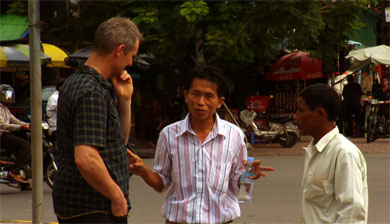 Rob, Veasna and Cheam Souer
Rob, Veasna and Cheam Souer Veasna, Mr Bou Meng and Rob
Veasna, Mr Bou Meng and Rob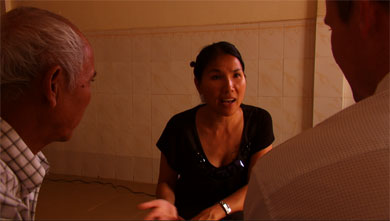 Kulikar translates for Mr Chum Mey
Kulikar translates for Mr Chum Mey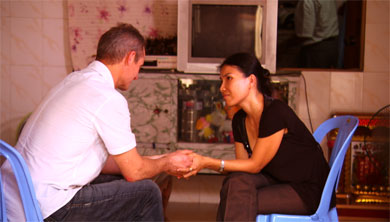 Kulikar comforts Rob
Kulikar comforts RobThis belief is widespread: and there is some reality to it. Cambodians do spend many hard hours studying and learning English. For sure, in a city populated by Anglophone well-wishers, do-gooders and business folk, translators are in demand. Apart from the sheer effort it takes to learn another language (and given Cambodia was a French colony, English is not a "natural" part of the country's history), translation is an extraordinary art.
In the ideal world of objective truth and pure facts, some claim that translators must be fully transparent, a neutral cipher, merely delivering up the question uttered. Translators according to this view must have no opinion and no impact on the scene before him or her – be it a business transaction or an interview. The reality of course is so different. Translation is always "imperfect" – words are never identical from language to language, and bring along with them culture, history, beliefs and world-views. And the translators are of course people whose identities are constructed through their language and their history. Cambodia's traumatic past is never far away, framing, filtering and shaping their understanding.
I decided early on as a director to include my translators as characters, given the crucial role they play, their own dramatic and painful histories and my admiration (given my own limited skills) of the linguistic abilities they display. Filming the process of translation also reveals much about documentary filmmaking. Translation slows and staggers the flow of information, revealing the mechanics of communication, miscommunication, comprehension, misunderstanding and cultural difference.
A rhythm is established that we settle into. In Brother Number One, the triumvirate of the translator, Rob, and a subject (sometimes a victim, other times a perpetrator), are all on screen. We see the translator ask the question we, Rob or I, pose. The answer cannot be too long as the translator must absorb the answer, mentally interpret it and relay its content. At times, the translator will ask in Khmer for clarification and a mini-interview, inaccessible to all of us Westerners, will ensue. Throughout this process, Rob scans the faces, reads body language, without understanding the words, keen for information. The roles then switch, with the subject watching Rob's response to his or her answer - at times with apprehension. Time is slowed and waves of emotion, anger, and sorrow can hang suspended, breaking slowly.
Translators can become overwhelmed with empathy for Rob, or, as often their own sorrow or anger rises to the surface. They can become too emotional to continue, or they interject with their own questions, their buried pain rising to the surface. I see them too frequently soften content so that the blows fall off Rob more lightly – they feel compelled to relay answers but also know that they will hurt. While I watch, it makes me reflect on the power, still, of the Anglophone speaker. Despite the world being in a "post-colonial" age, English, known as the "business language" appears to rule. In a country like Cambodia, deeply impoverished but with some real entrepreneurial spirit, the ambitious buckle down with English dictionaries painstakingly teaching themselves English word by word, so they can help those (yes, filmmakers, aid workers, businesspeople) that ironically are supposedly there to help them. I kept thinking, if that effort could be directed elsewhere: to their own professional development, to the acquisition of practical skills needed by their own people, perhaps, we the "helpers" would be less needed.
- Annie
Continue reading -
Day 2 in Cambodia
As always we all adjusted to jetlag and the heat in record time -- off the plane into our first day's filming. Beautiful plane ride over Siem Reap, home of Angkor Wat, seeing the low-lying rice paddies. Rice has been so much of Cambodia's story -- from being the ricebowl of Asia to starvation during the Khmer Rouge years. Now there is the incipient creep of factory developments replacing the paddies. Yesterday was full on, filming an artist who was imprisoned in Tuol Sleng, the "model prison" where virtually everyone was executed; Bou Meng is one of five living survivors as is Norn Chanpal who was 8 when the Vietnamese forces overthrew the Khmer Rouge in 1979. He had a heartbreaking memory of his mother stroking his hair and telling him to look after his little brother -- she was then taken away. He and his brother hid under a pile of old clothes. We are also following the dictum "every Cambodian has a story" which is true -- so are doing brief vignettes of all the people we meet "naturally" in the film . .translators, court officials, drivers and so on. I think, hope, this is working. Peter as always is doing a great job and we are bristling with cameras...
Continue reading -
Returning to Cambodia
We are finally going back to Cambodia to film the sentencing of Comrade Duch. Out of the five being tried, Duch is the only one who, at least for a while, acknowledged his guilt. He converted from Buddhism to Christianity after the fall of the regime and in fact was working for an American Christian aid organization on the border with Thailand. His new religion allows him to ask for forgiveness, so many Cambodians are understandably sceptical about his new faith, given that at least 14,000 were brutally tortured and murdered at Tuol Sleng under his rule. He has nonetheless provided some crucial information that presumably will be used during the next trial – that of three "Brothers" (and one wife) who were part of Pol Pot's powerful inner circle and who allegedly devised the policies that led to the deaths of up to 2 million Cambodians. They are assuming no responsibility.
Returning to CambodiaIn the meantime, Tim and I have been editing so that on our return to Cambodia, we can be more focused on the content we require. Our drives are already groaning with over 7 terrabytes filled.
Currently we are discussing the tension between pursuing Rob's emotional journey and the story of the Cambodians. There are a plethora of issues that arise – should one Westerner get such attention when so many millions of Cambodians suffered? Why should he not? He and his family suffered hugely and Rob thinks of the loss of his brother most days. But the Cambodian story is such a painful one, almost unimaginable. Does Rob's story help engage a Western audience and make them more likely to understand one of the worst genocides of the 20th century? It is commonplace to hear visitors to Cambodia end up saying "every Cambodian has a story" – which is very true, and one strategy we will try to follow is to explore the stories of the characters that Rob naturally meets.
The other tension is trying to get a balance between the personal story and the historical context. The roots of the genocide in Cambodia are complicated, involving of course the conflagration that was the Vietnam war – how much do audiences want to know? History seems important – otherwise, it is easy to see the Cambodian problem as something "over there", nothing to do with the West, but of course looking at the illegal bombing of Cambodia, the support of the brutal Lon Nol one can start to understand how a regime like the Khmer Rouge can arise. But can we tell the history accurately without becoming dry and too detailed? Always a challenge.
Continue reading -
A year into production...
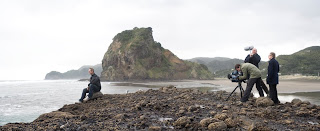 A year into production
A year into productionOne year on and two-thirds of the way through production on Brother Number One. 80 hours of material and counting! The film has taken us to the US, the UK, Australia, around New Zealand and of course to Cambodia – and our plan is to return there once Comrade Duch, the Rouge leader whose trial finished late last year, is sentenced.
Duch was the man – sometimes referred to as Pol Pot’s favourite torturer – that would have sealed Kiwi yachtie Kerry Hamill’s terrible fate. He and his sailing mate Englishman John Dewhirst were killed at the notorious Tuol Sleng prison under Duch’s command (we could put into two of three of the black and white images from TS with the Susan Sontag quote) and it is their story (and Rob Hamill’s journey) of course that forms the central thread of the film. The entire Khmer Rouge regime – almost four years of genocidal rule from 1975-79 by a small group of Khmer ultra-Maoists – would seem almost fanciful if the consequences of that period were not so devastating.
Documentary filmmaking is such a process. No matter how prepared one is, how tightly scripted, reality always intercedes and life reveals itself in all its beauty and its horror. I always think one has to marshall the full armory (to use a military metaphor) of emotional and intellectual decision-making while directing documentary -- understanding, analysing, empathizing, recognizing where a story might be taking you. But producing is also such a complex and overlooked process: a business, an art, managing an ever changing technical landscape, managing people. A bit like being a conductor and keeping everyone moving pretty much at the same speed in the same direction...
Continue reading -
News from Annie on returning from the U.S
Have just recommenced shooting and editing having returned from a whirlwind tour to the US first to attend the American Historical Association conference where my last film An Island Calling was showing (sharing a panel with the lovely Vilsoni Hereniko and Tarcisius Tara Kabutaulaka), then onto LA where we went to visit the Shoah Foundation Institute, which was begun by Steven Spielberg as an archive of Holocaust testimonies. Shoah’s mission statement is to ‘To overcome prejudice, intolerance, and bigotry—and the suffering they cause—through the educational use of the Institute’s visual history testimonies’ and to date they have collected nearly 52,000 video testimonies of Holocaust survivors and other witnesses in 32 languages and from 56 countries.
I caught up with old friends and met new ones. Had one of those great mixed restaurant dinners which makes one feel a bit old -- Kiwis living in the US, Americans living in New Zealand, old friends from New York, Peter Gilbert who came over from Chicago and met new people, Abbie, Alan, Ben ...
Modelling ourselves on the Shoah example, we are now doing a series of life stories with “Khmer Kiwis” living here as part of the website that will accompany the film. Chakara and Anna have spent two days filming stories which we will excerpt, attaching them as an extensions to our website, in time making the entire stories available. We will house the master tapes with the Cambodian community here and hopefully this will start a move to accrue more stories for the future, and for the young. Meanwhile, I’m back at the editing bench extending our sample in the ever-ending search for more film funding.
No word yet on when Comrade Duch will be sentenced, which is the time we hope to return to film again.
Continue reading -
Director’s diary - Annie Goldson
 Photo: Mark Servian
Photo: Mark ServianBack from Cambodia nearly a week now. I think it was difficult for all of us to process what we saw and experienced. Working something like 11 x 12/13 hour days, we had to focus on what was in front of us, ensuring we stayed sensitive to our subjects, adhered to the schedule but remained open to unexpected storylines when they revealed themselves.
And then there is always the practical demands: changing and numbering tapes, charging batteries, making sure there was enough light, finding power sources and so on. The usual demands but in place that had felt like no other. Now the intense focus of production has elapsed I find Cambodia returns in my dreams, my psyche’s attempt to cope, after the fact, with the surreal horrors of Tuol Sleng and the Killing Fields.
Something most Cambodians have to deal with on a daily basis. That was what struck me – how many stories, untold stories, are out there waiting to be told and how many people we came across that told us of the nightmare that that had been their past. Memories made harder too, because of the lack of accountability for and acknowledgement of these crimes. The past hurts can only ever be very partially salved by the Court process, whatever its outcome.
Rob was amazing to work with, showing courage and dignity at every step. He has always had an ability to express strength of will, along with an extraordinary openness of emotion (often seen as contradictory). The Cambodians we spoke with were immensely grateful for his stand in Court: he was able to express things that perhaps they felt less able to.
There were optimistic moments while filming too, especially working with DC Cam and seeing the multi-dimensional work that they undertaking to try to address the past, from writing the first real history books, through conducting outreach programmes. to attempting to institute reconciliation between perpetrators and victims, plus much more.
There were fun times too, hanging out with Kulikar, our “translator/character” and Vothar, our great “slow and steady” driver who managed to negotiate us through extreme traffic with grace and care. And watching the spectacular display at the stadium in the early evening as forty competing aerobics teams, dancing to separate rhythms, strive for fitness. A soccer game goes on beneath them largely unnoticed while kites and balloons whirl overhead.
Continue reading -
Blessing day shoot NZ
 James, Annie and Rob at the Blessing with Chakara Lim
James, Annie and Rob at the Blessing with Chakara Lim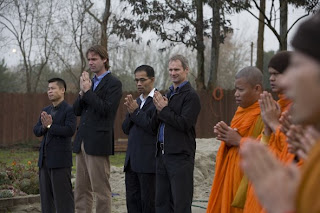 Flag-raising ceremony
Flag-raising ceremonyOur first day’s filming in New Zealand went smoothly, beginning with our being blessed by Buddhist monks at the temple in Takanini. We headed off early to the outskirts of Auckland, where the suburbs blend into farmland. Behind what looked like a farmhouse was a large shed filled with colour, posters, ribbons, cloth — the beautiful burnt oranges and browns of Buddhism. We filmed the preparation, the monks (who came from Laos, Tibet, Thailand as well as Cambodia), mounting flags along a concrete wall at the road frontage, then captured some shots of the Cambodian community drifting in, older women making food, children running around, friends chatting in the early morning light.
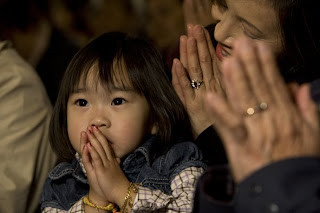 At the Blessing ceremony
At the Blessing ceremonyIt felt much like Cambodia although I tried to frame some of the Kiwi elements in shots, too — the landscape, our particular washing lines, Non Smoking signs and so on. One of the monks then oversaw the flag-raising -- the New Zealand and Cambodian flags mounted together. There was some haunting singing by the flag pole, during which it began raining which felt atmospheric.
The actual blessing was amazing too, about 10 monks all lined up chanting and tossing water on us with slender sticks. The chanting is very mesmeric. Rob, James and I each spoke briefly, with our associate producer Chakara Lim translating skilfully. The community is very interested and incredibly supportive – some had travelled from Wellington for the event.
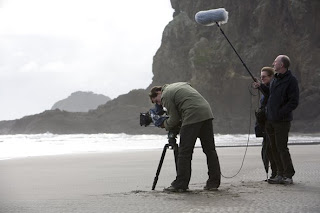 The crew at Piha
The crew at PihaAmy Wang from Asia Down Under was filming too, a spot on the “making of” for the show – so people should look out for that. She interviewed us, but also Sarath Lim, the president of the Cambodian (Khmer) Community of New Zealand, a gracious and dignified man who underwent the trauma of living in Cambodia under the Khmer Rouge. We then took off for Piha Beach, where we filmed the “briny” which was doing its usual West Coast thing, wild waves, cascading skies etc. I want these shots as an “opener” to a sample I’m editing to help us with further fundraising. Although we have gotten good funding from NZOA and TV3 and in fact, many donations from the Cambodian community and others, this is an ambitious film as we will be travelling with a crew around Cambodia and in addition, we would like to use archives which can be expensive.
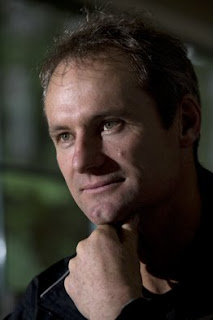 Rob Hamill
Rob HamillI want to follow up our Hotdocs contacts with an example of what we have filmed thus far so will send them a sample as soon as I can. The sea plays a bit part in our film – the Hamills, as children, swam, surfed and sailed around Whakatane and the Heads; Kerry was seized off his beloved boat, Foxy Lady; and Rob, of course, achieved the almost unachievable, rowing the Atlantic in 41 days. After getting some picturesque shots off the rocks, he headed for the warmth of Dave the soundperson’s house, where we did another “diary interview” with Rob, following up one we had done in the UK, and then we relocated to the couch, where he read through some of the so-called “confessions” extracted from his brother and John Dewhirst, the Englishman who suffered the same fate as Kerry.
Understandably, Rob got pretty emotional and it can be difficult to keep filming at those times – one always feels so intrusive. The final scene of the day was my “replicating” one of the typed confessions – James had tracked down an old Remington and we finished up the day with me punching out “highlights”. Those Remingtons certainly have a different finger action to my MacBook Pro. So all in all, it was a pretty full day and I look forward to seeing Jake’s footage. Here are some stills from the day, filmed by a real “pro” Marcel.
Continue reading -
Annie's updates from the US and UK
 Rob and Peter
Rob and Peter Rob and Hilary
Rob and HilaryAfter sending my Hotdocs party clothes back to New Zealand, Peter Gilbert (one of our two DOPs) and I set off to begin shooting. We started with three historians/participants in the US. All have had a real commitment to Cambodia — for example one of the three Elizabeth Becker lived in Cambodia up until 1975 when she was thrown out by Pol Pot. She was then asked back by him for a propaganda tour and one in her party of three was murdered during that last trip. The three historians all managed to make Cambodia’s history, a complicated Cold War affair, lucid and accessible so that was an encouraging start.
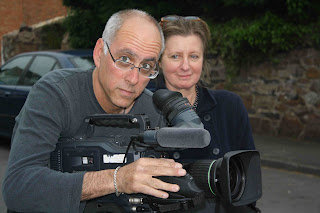 Annie and Peter
Annie and PeterWe then set off for the UK which went really well although emotionally difficult at times. We started in Loughborough in the midlands and interviewed two Englishmen who had been on Foxy Lady just prior to the fatal voyage and had not known of the murders until a few years ago. We filmed them in a very picturesque pub — despite the three decades intervening, they remained very emotional. And then we headed north to interview Hilary, John Dewhirst’s sister (he was the Englishman tortured and killed along with Kerry Hamill).
Although I have known about Pol Pot of course, the reality of the pain he has caused really hit me through Hilary. She lives in this exquisite Lake District area full of old stone walls and cute villages, not far from where she and John were brought up. She has been unwilling to be interviewed before about her brother and in this instance, is prepared to because of Rob Hamill ‘s(the brother of the murdered Kiwi) key role in the film. He of course will be confronting the man, Comrade Duch, responsible for the treatment of their two brothers. I know Rob will be speaking for Hilary as well as for himself.
Rob is really strong on camera — a real Kiwi sportsperson who unusually enough, is prepared to express grief and emotion. Both he and Hilary can barely comprehend what the Cambodians must have been through — and mentioned the trauma of the country constantly.
And Peter Gilbert as DOP was brilliant not just on camera but also as a “directorial advisor”. Even though I have taught myself for so long, I am self-taught, so it was great to feel a bit “mentored”. Plus he is funny and communicative and really helped during the tough moments. So all good.
Continue reading -
Hotdocs - Annie's thoughts before the trip...
Am packed and ready to attend Hotdocs to pitch Brother Number One before a powerful and discerning group of funders. It all takes place in a kind of cloister at the University of Toronto – thousands of other documentary producers attend, either sitting in the bleachers or hanging from rafters it seems.
Hotdocs for me is one of the finest documentary events in the world and this is a great, albeit a bit scary opportunity. We have gotten generous support from TV3 and New Zealand on Air and some fabulous private investors, but the project is ambitious. The reality is that the war crimes tribunal currently underway in Phnom Penh sends prices sky-rocketing so we need to eke out our dollars to make sure they last the distance. James Bellamy and Rob Hamill, the originating producers have been toiling away on research and fundraising tirelessly for two years now—and thanks to their efforts, it seems now the film is on a roll.
Somehow Hotdocs—as both a festival and a marketplace—manages to be big and professional but still very personal. It was where I premiered Punitive Damage in 2000, which was to be a significant film for me, my first cinema release and a film that received a lot of critical and some commercial success. Punitive Damage followed New Zealander Helen Todd who sued an Indonesian general after her son Kamal was shot and killed in the Dili massacre in 1991.
By chance, the film was released as huge changes unfolded in Asia and East Timor – the run up to the referendum on independence (thousands of Timorese were intimidated and subjected to violence, interrogation and disappeared, the trashing of Timor by departing Indonesian military), and the nation’s final independence. I was back the following year to Hotdocs to pitch Georgie Girl, my next film, which showed in the festival two years later – then last year, An Island Calling screened and this year, I will be back again with Brother Number One. So Hotdocs and I, I have to say, have a history - and it will be great to catch up with a documentary community whose spirit and determination I treasure.
In many ways, this new film replicates some of the horrendous background elements of Punitive Damage – Cambodia, like Timor, was caught in the crossfire of Cold War politics, with Kissinger playing a bit part behind the scenes. Cambodia and Timor lost almost a third of their population through execution and starvation, Timor to the Indonesian occupiers, who were funded by the US and Britain, Cambodia to the Khmer Rouge, funded by China but some would argue, given impetus after the US bombed Cambodia and sent thousands of angry peasants into the arms of the ideologues.
Both films too deal with attempts at finding justice. New Zealanders who unwittingly found themselves drawn into the tragedies—whose determination speaks of an attempt to ameliorate some of their own grief and pain, but also a willingness to speak for local populations whose suffering was almost unimaginable.
After Hotdocs, I will commence filming – first in the US with three historians, Elizabeth Becker, Ben Kiernan and Peter Maguire, and then in the UK – with friends and family of John Dewhirst, the young Englishman tortured and murdered alongside Kerry Hamill. Rob is coming too, and will meet John’s sister Hilary for the first time. I know it will be very emotional for all of us...
Continue reading -
Brother Number One selected to be pitched at The Documentary Forum at Hotdocs in Toronto
Brother Number One, a working documentary on the torture and murder of New Zealand yachtie Kerry Hamill by the Khmer Rouge in 1978 has been selected to be pitched at the prestigious TDF forum at Hotdocs, the International Documentary Festival in Toronto. Only 25 projects were selected from over 350 submissions. Most of the major broadcasters, theatrical funders, and distributors worldwide attend the TDF looking for new projects to invest in.
In the mid-70s, Kerry bought a yacht, Foxy Lady, and was running a charter business out of Darwin around South East Asia with a Canadian friend, Stuart Glass. Along with an Englishman, John Dewhirst, they were sailing towards Bangkok when they hit a storm. Mistakenly entering Cambodian waters, Foxy Lady was seized, Stuart Glass shot and killed, while the other two men were taken to the notorious Tuol Sleng prison, overseen by Pol Pot’s main executioner, now turned Christian, Comrade Duch. Over 14,000 Cambodians were killed at the torture centre, which is now a genocide museum.
Kerry’s younger brother Rob Hamill, an Olympic and Trans-Atlantic champion rower, will travel to Cambodia to retrace the steps taken by his brother and John Dewhirst, speaking to eyewitnesses, perpetrators and survivors. Rob’s journey will culminate in his giving a Victim’s Statement before the Extraordinary Chambers of the Court of Cambodia. Comrade Duch, the man that oversaw his brother’s torture and murder is currently on trial at the ECCC. New Zealander Dame Sylvia Cartwright is a senior judge on the tribunal.
The film will also explore the history of Cambodia in an attempt to comprehend the enormity of the genocide that occurred in Khmer Rouge years 1975-1979. A former French colony, Cambodia was sucked into the vortex created by the Cold War and was illegally bombed by the Nixon administration which some see as creating the conditions for the rise of the fanatical Pol Pot.
Brother Number One is being produced by James Bellamy, Annie Goldson and Rob Hamill. Annie is directing, and after Hotdocs will film in both the US and UK with historians and with Dewhirst family members and friends. American DOP Peter Gilbert (Hoop Dreams, At the Death House Door) an Academy-nominated cameraperson, will shoot with Annie in the US and UK. Jake Bryant (The Artstar and the Sudanese Twins) will film in Cambodia, New Zealand and Australia later this year.
The film has received generous funding from TV3 and New Zealand on Air and is currently seeking further presales. The crew is working closely with the Cambodian community in Auckland who will conduct a blessing prior to the commencement of production.
Continue reading

